50 paise
On the reverse we can see a woman with a man holding the Indian flag, and in the background there is the Indian parliament. The writing on the right reads 25veen swatantarya jayanti meaning the 25th year of the Indian independence. India got its independence in 1947 and this coin was released in 1972, 25 years after the independence.
The reverse shows the denomination, the country, and the four headed lion symbol at the top.
This coin was minted in the commemoration of the completion of fifty years of independent India. India got its independence in 1947, and this coin was minted fifty years after that, ie in 1997. The Hindi inscription reads "swatantrata ka 50van varsh", which means the 50th year of Indian independence. The same is written in English as well. The figure shows Mahatma Gandhi leading many Indians in the Indian freedom struggle. In particular, it depicts the event of Dandi march. The British had imposed a tax on salt, and Gandhi decided to do a salt satayagrah.
The Salt Satyagraha was a campaign of non-violent protest against the British salt tax in colonial India which began with the Salt March to Dandi on March 12, 1930. It was the first act of organized opposition to British rule after Purna Swaraj, the declaration of independence by the Indian National Congress. Mahatma Gandhi led the Dandi march from his Sabarmati Ashram to Dandi, Gujarat to make salt tax free, with growing numbers of Indians joining him along the way. When Gandhi broke the salt laws in Dandi at the conclusion of the march on April 6, 1930, it sparked large scale acts of civil disobedience against the British Raj salt laws by millions of Indians. This event was very significant in India's struggle for independence.
The image shown on the coin's obverse, the Dandi March , has also been immortalized in various places as a statue, or rather a series of statues of Mahatma Gandhi and his followers.
The reverse shows wheat ears. Wheat is the staple food crop in India. The writing in Hindi reads adhik ann ugao which means grow more food.
 |
| 50 paise 1917-1984 Indira Gandhi |
Indira Priyadarshini Gandhi(1917-1984) was the prime minister of India for three terms, from 1966 to 1977; and fourth term from 1980 to 1984, when she was assasinated in the wake of operation blue star.
She is the only female prime minister of India till date, and was the daughter of Jawaharlal Nehru, the first prime minister of independent India. She married Feroze Gandhi (no relation to Mohandas Karamchand Gandhi, also called Mahatma Gandhi). She was brought up in a politically strong and influential household, and after the sudden demise of Lal Bahadur Shastri, she was thrust into the foremost ranks of congress by the congress president K.Kamaraj. She made politically correct moves and very influential, so she came into power. But some inabilities and some inefficiencies led to the enforcing of the emergency in the late 1970s. This caused her to be out of power for three years. She also devalued the rupee from 4 Re to a dollar to 7 Re/dollar, and charges of corruption were proved against her, but she refused to resign.
In 1984, some extremists in Punjab were in the holy shrine of Darbar sahib in Amritsar, and she went through with the hard military operation against those people, forgetting about the place and the civilian pilgrims there. This operation was named 'operation bluestar', and was the cause of her assasination at the hands of two of her bodyguards, Satwant Singh and Beant Singh.
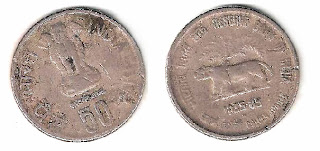 |
| 50 paise 1935-85 |
The reverse shows the denomination, country, the four headed lion symbol, and "satyamev jayate" is written in Hindi. It means : truth alone triumphs. This was a question to Jamal Malik in the movieSlumdog Millionaire, for which he took an audience poll. The movie recently won as many as eight Oscars.
The reserve Bank is the Federal Bank of India and performs the following functions:1)Monetary Functions in India: Formulates, implements and monitors the monetary policy – to ensure price stability and optimum flow of credit to productive sectors.2)Regulatory and supervisory functions in India: Prescribes broad parameters of banking operations within which the country's banking and financial system operates - to maintain public confidence in the system, protect depositors' interest and provide cost-effective banking services to the public.3)Management of Foreign Exchange in India: Manages the Foreign Exchange - to facilitate external trade and payment and promote orderly development and maintenance of foreign exchange market in India.4)Issuance of currency in India: Issues and exchanges or destroys unfit currency and coins - to cater the public with adequate quantity of supplies of good quality currency notes and coins. 5)Developmental functions in India: Performs a wide promotional functions to meet national objectives.6)Other Related Functions: Banker to the Government of India: performs merchant banking function for the central and the state governments; also acts as their banker.The inscription at the bottom on the obverse reads "swarna jayanti" which means golden jubilee. The same is written in English as well. The Reserve Bank of India can be read in English and Hindi both. The Reserve Bank was established in 1935, and completed its 50 years in 1985. The symbol on the obverse shows a lion and a palm tree. This symbol is the mascot of the Reserve Bank of India. This symbol was adapted from the lion and palm tree was taken from the golden mohur (15 rupees) of William iiii. The mohurs of William iiii were the first proof coins minted in India.  |
| 50 paise 1947-1972 |
 |
| 50 paise 1947-1997 |
This coin was minted in the commemoration of the completion of fifty years of independent India. India got its independence in 1947, and this coin was minted fifty years after that, ie in 1997. The Hindi inscription reads "swatantrata ka 50van varsh", which means the 50th year of Indian independence. The same is written in English as well. The figure shows Mahatma Gandhi leading many Indians in the Indian freedom struggle. In particular, it depicts the event of Dandi march. The British had imposed a tax on salt, and Gandhi decided to do a salt satayagrah.
The Salt Satyagraha was a campaign of non-violent protest against the British salt tax in colonial India which began with the Salt March to Dandi on March 12, 1930. It was the first act of organized opposition to British rule after Purna Swaraj, the declaration of independence by the Indian National Congress. Mahatma Gandhi led the Dandi march from his Sabarmati Ashram to Dandi, Gujarat to make salt tax free, with growing numbers of Indians joining him along the way. When Gandhi broke the salt laws in Dandi at the conclusion of the march on April 6, 1930, it sparked large scale acts of civil disobedience against the British Raj salt laws by millions of Indians. This event was very significant in India's struggle for independence.
The image shown on the coin's obverse, the Dandi March , has also been immortalized in various places as a statue, or rather a series of statues of Mahatma Gandhi and his followers.
 |
| 50 paise 1973 |
 |
| 50 paise 1975 |
India became independent on 15 August 1947 and was left with a legacy of non-decimal coinage. One rupee was divided into 16 annas or 64 pice, with each anna therefore equal to 4 pice. In 1957, India shifted to the decimal system, but for a short period both decimal and non-decimal coins were in circulation. To distinguish between the two pice, the coins minted between 1957 and 1964 have the legend "Naya Paisa" ("new" paisa). The denominations in circulation were 1, 2, 5, 10, 20, 25, 50 (naya)paise and one rupee which remained as the same pre-decimal value. Therefore pre-decimal coins of one, half and quarter rupees could remain in circulation after decimalisation.
Chronologically, the main considerations influencing the coinage policy of Republic of India over time have been: The incorporation of symbols of sovereignty and indigenous motifs on independence; Coinage Reforms with the introduction of the metric system; The need felt from time to time to obviate the possibility of the metallic value of coins rising beyond the face value; The cost-benefit of coinisation of currency notes.
The Ashok-Stambha (Ashoka's Pillar) is a motif on all Republic of India coins. The symbol is a representation of peace and non-violence.
 |
| 50 paise 1982 |
The reverse shows the denomination, country and the four headed lion symbol. The obverse shows the map of India, and a map within it. The small dots on the left are the Lakshadweep Islands, and the line of dots below the "national integration" inscription and the Andaman and Nicobar Islands. The Hindi inscription above the map reads "rashtriya ekta" which means national integration. The date can be seen at the bottom.
 |
| 50 paise 1985 |
India became independent on 15 August 1947 and was left with a legacy of non-decimal coinage. One rupee was divided into 16 annas or 64 pice, with each anna therefore equal to 4 pice. In 1957, India shifted to the decimal system, but for a short period both decimal and non-decimal coins were in circulation. To distinguish between the two pice, the coins minted between 1957 and 1964 have the legend "Naya Paisa" ("new" paisa). The denominations in circulation were 1, 2, 5, 10, 20, 25, 50 (naya)paise and one rupee which remained as the same pre-decimal value. Therefore pre-decimal coins of one, half and quarter rupees could remain in circulation after decimalisation.
Chronologically, the main considerations influencing the coinage policy of Republic of India over time have been: The incorporation of symbols of sovereignty and indigenous motifs on independence; Coinage Reforms with the introduction of the metric system; The need felt from time to time to obviate the possibility of the metallic value of coins rising beyond the face value; The cost-benefit of coinisation of currency notes.
The Ashok-Stambha (Ashoka's Pillar) is a motif on all Republic of India coins. The symbol is a representation of peace and non-violence.
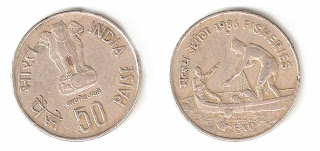 |
| 50 Paise 1986 FISHERIES |
This 50 paise coin shows the four headed lion symbol and the denomination on the reverse. We can also see "satyamev jayate" in Hindi. This phrase means 'truth alone triumphs'. This was a question to Jamal Malik in the movie Slumdog Millionaire, which recently won as many as eight oscars.
The obverse of this 1986 fifty paise coin commemorates the fisheries industry of India. India is a peninsula and has a very long coastline. A large number of people earn their livelihood through fishing, and this also provides for the food of thousands of people in India. The fishing industry of India has grown five-fold since its independence in 1947. The inscription in Hindi says "matsya udyog" which means fisheries industry.
The obverse of this 1986 fifty paise coin commemorates the fisheries industry of India. India is a peninsula and has a very long coastline. A large number of people earn their livelihood through fishing, and this also provides for the food of thousands of people in India. The fishing industry of India has grown five-fold since its independence in 1947. The inscription in Hindi says "matsya udyog" which means fisheries industry.
 |
| 50 paise 1989 |
India became independent on 15 August 1947 and was left with a legacy of non-decimal coinage. One rupee was divided into 16 annas or 64 pice, with each anna therefore equal to 4 pice. In 1957, India shifted to the decimal system, but for a short period both decimal and non-decimal coins were in circulation. To distinguish between the two pice, the coins minted between 1957 and 1964 have the legend "Naya Paisa" ("new" paisa). The denominations in circulation were 1, 2, 5, 10, 20, 25, 50 (naya)paise and one rupee which remained as the same pre-decimal value. Therefore pre-decimal coins of one, half and quarter rupees could remain in circulation after decimalisation.
Chronologically, the main considerations influencing the coinage policy of Republic of India over time have been: The incorporation of symbols of sovereignty and indigenous motifs on independence; Coinage Reforms with the introduction of the metric system; The need felt from time to time to obviate the possibility of the metallic value of coins rising beyond the face value; The cost-benefit of coinisation of currency notes.
The Ashok-Stambha (Ashoka's Pillar) is a motif on all Republic of India coins. The symbol is a representation of peace and non-violence.
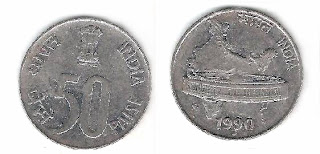 |
| 50 paise 1990 |
This 50 paise coin shows the denomination country and the four headed lion symbol on the reverse, and the date, mint mark, country, a map of India, and the Indian Parliament on the obverse.
The Indian parliament has two houses, namely the Lok Sabha and the Rajya sabha. The Lok Sabha is also called "house of the people" or the lower house. The members are elected directly by the people from different consitutencies, and these elected members choose or elect the prime minister of India. There can be at most 552 members in this house. The Rajya sabha is also known as the "council of states" or the upper house. Its members are indirectly elected by members of the legislative assemblies of the different states. The Rajya Sabha has 250 members in all. Elections to it are scheduled and the chamber cannot be dissolved. Each member has a term of 6 years and elections are held for one-third of the seats after every 2 years. The members of the Rajya sabha have to be distinguished members are essentially distinguished personalities in their respective fields.


.JPG)
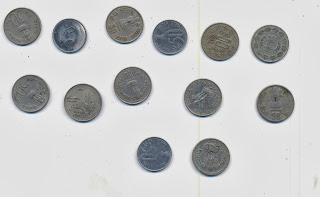
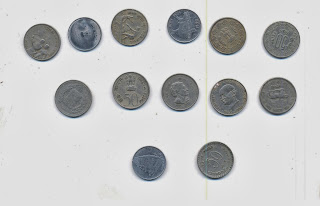
No comments:
Post a Comment